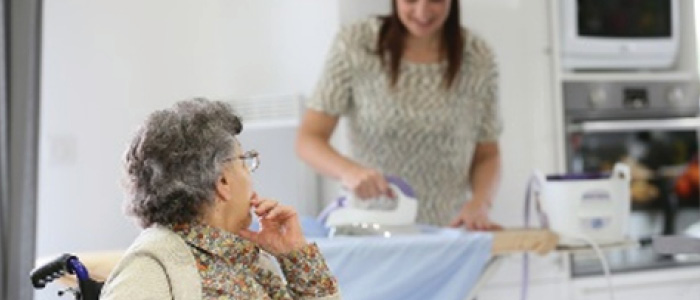A common perception today is that it’s cheaper for aging adults to stay in their home as long as possible versus moving to a community-based setting. However, that is not always the case. Here are three reasons why:
1. Home modifications and upkeep
Depending on the layout of your home, modifications may be necessary as you age in order to make the home safer and more navigable when mobility declines. Basic home modifications such installing grab bars, sturdying rails, replacing dangerous rugs, and putting in better lighting can cost up to $10,000. More extensive modifications such as removing (or reducing the height of) steps, widening hallways, adding a ramp, lowering cabinets or appliances, installing no-step showers, and possibly even installing a generator to protect against power loss–particularly in the extreme summer or winter months–could easily add up to $100,000 or more, depending on the size of the house and whether it is one or two stories.
Check out our blog from earlier this month, “Aging in Place: How Much Will Those Renovations Cost?,” where EGStoltzfus Custom Homes and Remodeling Division shares how much typical home renovations may cost to make your home compatible with your needs as you age.
Not doing the necessary modifications could put you or a loved one at risk for an accident that could ultimately cost more than the modification, and could result in significant health issues.
In addition to home modification, there also is the cost of occasional repairs. Home ownership is expensive and can be even more so if a house becomes neglected over time. Replacing a roof or heating system can easily cost $6,000 or more. Other unforeseen expenses will inevitably pop up that can easily exceed $1,000 each time.
Then there are the ongoing maintenance and living costs such as housekeeping, yard maintenance, gutter cleaning, groceries, increasing property taxes, lightbulbs, air filters, utilities, and more. These expenses can easily total several thousand dollars or more each month. If you still have a mortgage payment, which is far more common for seniors today than in the past, this adds to the cost.
2. Care services may cost more than you think
Between 50 and 70 percent of people over the age of 65 will eventually need significant help with their day-to-day tasks and overall care. The national average cost of in-home care is around $3,800 per month, based on 44 hours of care per week, or around 6 hours per day. Some seniors will need less than 6 hours of care per day, while others may need more. But when you consider that you may need homemaker services as well as home healthcare services, the hours may add up to more than you think, particularly as your needs progress.
Plus, there are other paid services that you may need, such as monitoring services, adult daycare, bill paying and recordkeeping, and other assistive technology. These services could easily add up to another $500 – $1,000 per month, depending on which services you need or choose.
By comparison, the national average cost of an assisted living community is actually less at $3,628 per month. To be fair, this, too, could be much higher depending on the level of care you need. Skilled nursing care, the highest form of care, is often provided in a community setting, where it costs $7,000 or $8,000 per month on average. Skilled care typically means 24-hour care, so no matter whether it is provided in a facility or at home, the cost will be substantially higher.
An important point to keep in mind when thinking about the total cost of care and other services while staying in the home is that these expenses are in addition to potential modifications and the other home maintenance costs described above.
3. Impact on the next generation
The majority of caregiving in the home is provided by unpaid family members. Clearly, relying on the care and support of loved ones is cheaper, on the surface, than hiring paid care. But there is often a hidden cost to this approach. Family caregivers often have to take time away from their own careers or even retire early. Research reveals that the average lost lifetime wages and benefits of an unpaid family caregiver is almost $304,000. Therefore, in many cases, the cost of aging in place is essentially passed on to the next generation in the form of lost compensation and future benefits.
Additionally, studies show that approximately half of all family caregivers pay at least $5,000 per year out of pocket, year over year, for things like food, medication, and bills for their aging loved one.
Aside from the loss of wages and benefits, and out-of-pocket costs, unpaid family caregivers experience other non-financial costs including mental, emotional, and even physical strain. Many caregivers report high levels of stress and even depression, which can lead to other health problems…and increased healthcare expenses.
Adding it all up
It is logical that a majority of aging adults would want to stay in their own home for as long as possible –it’s comfortable and familiar to them and likely contains countless fond memories. And while at first blush it seems that aging in place would be the most economical solution for seniors, that isn’t always the case, especially if unforeseen health issues arise. So get that calculator out of the desk drawer and start doing the math to see if it is really that much less expensive (especially in the long term) for you or your loved one to stay in the house.

